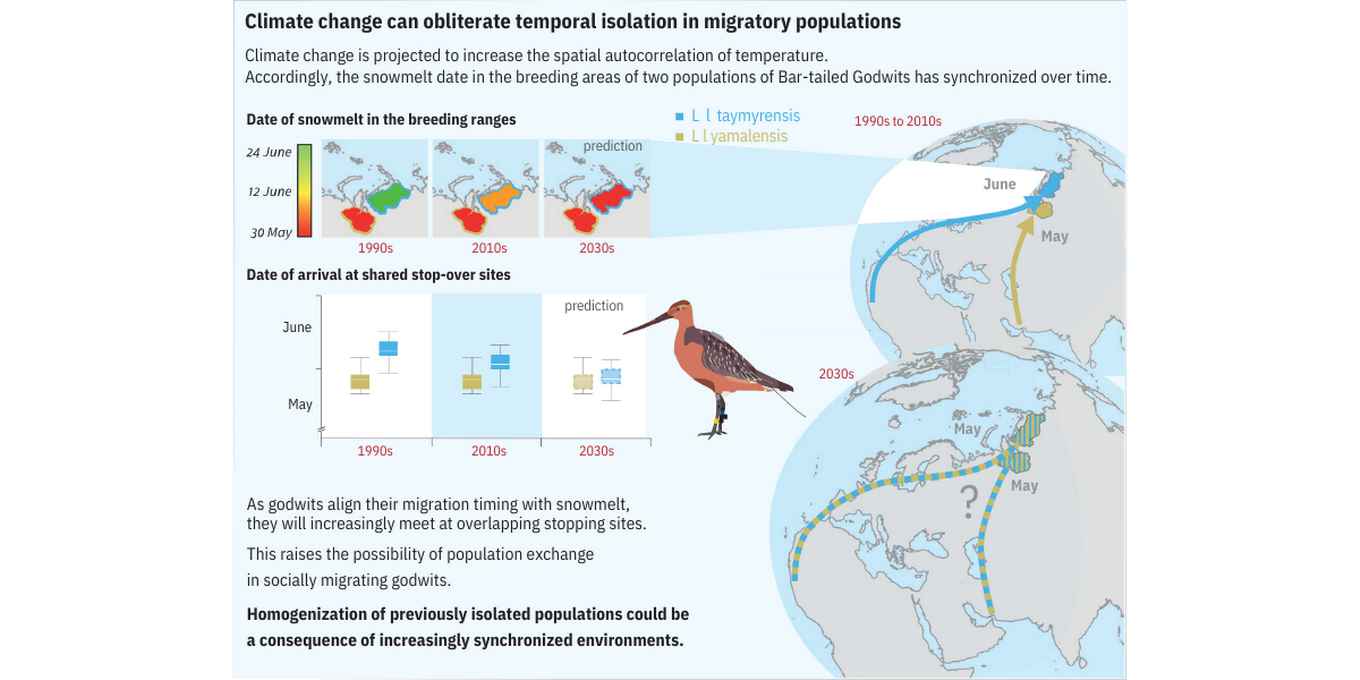Changing climate homogenizes diversity in migratory birds
13 December 2023

Global warming makes the snow melt earlier in the Arctic breeding grounds of the bar-tailed godwit. But the changes are not happening at the same pace everywhere. On the Siberian peninsula of Taimyr, snow melted half a day earlier each year between 1997 and 2020. On Yamal Peninsula, southwest of Taimyr, there was no measurable advance in snowmelt during that period.
Two subspecies
Both territories host different subspecies of the bar-tailed godwit: Limosa lapponica taymyrensis on Taimyr and Limosa lapponica yamalensis on Yamal. In both areas, the birds normally arrive several days before the snow melts. Thus, by advancing the snowmelt on Taimyr, L. l. taymyrensis arrived in the breeding areas about five days earlier in the last two decades than in the two decades before that. This is shown by birds that were fitted with light weight transmitters.
Overlap
The two populations of bar-tailed godwit do not live strictly separate lives. In spring, they may encounter each other in an area south of the two breeding areas. So far, this does not happen very often, because the yamalensis birds have a slightly earlier travel schedule than the taymirensis¬specimens. But now that the taymyrensis birds are migrating earlier and earlier, the birds are also encountering each other more often in western Siberia.
Social birds
'Bar-tailed godwits are social migratory birds,' lead author Roeland Bom (NIOZ) explains. 'There is a chance that individuals of the taymyrensis subspecies will join yamalensis more often and vice versa. Since both subspecies can interbreed without difficulty, this would mean that the distinction between the subspecies would slowly disappear.'
Homogeneous population
If the researchers extrapolate the current trend, they anticipate that the travel schedules will completely overlap sometime between 2036 and 2040. Whereas taymyrensis is currently still migrating along a western route, via the Wadden Sea to West Africa, and yamalensis is migrating along the Urals to the Caspian Sea and the Arabian Peninsula, this could eventually become one large, homogeneous population.
Loss of diversity
Migratory bird researcher Bom is first and foremost fascinated by these possible developments in the migration of the two subspecies. As a biologist, however, he is also concerned about the potential loss of diversity. 'The resilience of plant and animal species depends on genetic diversity. Climate change now threatens to create a kind of uniformity that could come at the expense of loss of diversity among the godwits.'
Unexpected challenge
His co-author Eldar Rakhimberdiev of the UvA’s Institute for Biodiversity and Ecosystem Dynamics adds: 'These results do not apply solely to godwits. In a few decades, latitudinal differences in spring phenology will disappear for many more temporally isolated populations. This implies that, in addition to the rise in temperature and shift in phenology, one of the unexpected challenges posed by climate change is the homogenization of animal populations worldwide.'
Publication details
Roeland A. Bom, Theunis Piersma, José A. Alves & Eldar Rakhimberdiev: Global temperature homogenization can obliterate temporal isolation in migratory animals with potential loss of population structure, in: Global Change Biology, 30, e17069. https://doi.org/10.1111/gcb.17069